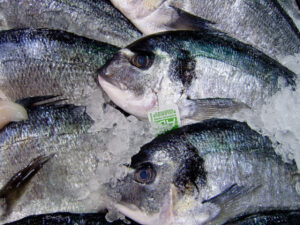Are You Worried About Mercury in Fish? This Graphic Can Help

The other day, I was chatting with my Mom about seafood. Between existing knowledge about mercury in fish, news about Fukushima radiation heading for the West Coast, and still unanswered questions about the impact of the BP oil spill in the Gulf of Mexico, we wondered aloud whether it was really safe to still be eating the stuff.
You don’t have to be a scientist to realize our oceans are in pretty bad shape. Decades of over-fishing have decimated the world’s fish stocks. The Environmental Defense Fund states that 87 percent of the world’s assessed fish stocks are at the breaking point, classified as overexploited or fully exploited.
Meeting our demand for fish and other seafood also affects other marine animals, with thousands of dolphins, whales, and sharks killed each year–indirect casualties of over-fishing.
Then there’s industrial pollution. Mercury pollution has contaminated 18 million acres of lakes, estuaries and wetlands, as well as 14 million miles of rivers. Emitted into the air by power plants and industrial facilities, mercury in fish is no longer just a risk, but a reality.
The good news is, we don’t have to stop eating fish altogether. Not yet, anyway. The key is to avoiding unnecessary mercury in fish is to get educated on which species are the least contaminated. Using facts from the Natural Resources Defense Council, Environmental Defense Fund and others, the infographic below is a handy guide to avoiding mercury in fish while still enjoying the heart-healthiness of protein from the sea.

Related on Organic Authority
Radioactive Fish at Fukushima Could Wipe Out Fishing Industry for a Decade
Commercial Fishing Killing 300,000 Whales and Dolphins Annually
Google Earth Identifies Major Overfishing In Persian Gulf
Image: quinet
Infographic Source: Fix.com

